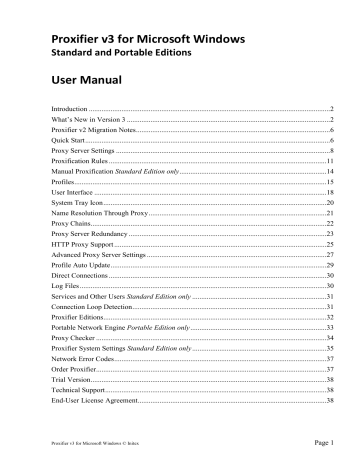
advertisement

You can use checkboxes to enable/disable particular proxies in the chain. This option has nothing to do with the failure status. If a proxy is unchecked, Proxifier will simply ignore it. On the other hand, a checked proxy can be marked as [failed] and ignored.
If the first proxy in such chain fails, Proxifier will mark it as failed and it will try the next one.
You will be provided with detailed messages that will render the status of the process.
The entire process is completely transparent for the client application. Proxifier can try several proxies without losing the initial connection request from the application.
Here is a typical session for failover procedure:
[02.01 11:18:37] iexplore.exe (2972) - proxifier.com:80 matching Default rule : using Failover proxy chain
[02.01 11:18:46] (Redundancy Chain) Failover - Could not connect to proxy primary.example.net:1080 - connection timeout (10 sec)
[02.01 11:18:46] (Redundancy Chain) Failover - New active proxy is backup.example.net:1080
[02.01 11:18:46] (Redundancy Chain) Failover - Trying next proxy.
[02.01 11:18:47] iexplore.exe (2972) - proxifier.com:80 open through Failover proxy chain
HTTP Proxy Support
(This topic is about HTTP proxy servers. Please do not confuse this with HTTPS).
Proxifier v3 for Microsoft Windows © Initex
Page 25
It is a common misconception to confuse HTTP proxy and HTTPS proxy. HTTP proxy servers can process HTTP connections (port 80). They can also support HTTPS connections (SSL) but usually such connections are only allowed on port 443 (the standard port for HTTPS). For example this is the default configuration for Squid and Microsoft ISA proxy servers. If an HTTP proxy allows HTTPS connections on arbitrary ports, it can be called HTTPS proxy server (also called CONNECT or SSL proxy). In this case it can be used for generic TCP connections like
SOCKS v4/5 proxy.
Proxifier can work with HTTP proxy servers that do not support HTTPS on arbitrary ports. Due to the technical limitation of this protocol it is only possible to process HTTP connections with such proxy servers. This means that you must configure the Proxification Rules accordingly.
You can enable HTTP proxy support at Profile->Advanced->HTTP Proxy Servers...
After that you will be able to add HTTP proxy server just like any other type of proxies. Once
HTTP proxy server is added, make sure that you properly set the Proxification Rules. If you want to process HTTPS connections through this proxy also, you should add this proxy separately as HTTPS.
Suppose proxy.example.net:8080 is a usual HTTP proxy and supports HTTP on port 80 and
HTTPS on port 443 and we want to configure Proxifier to process HTTP/HTTPS connections
(web browsing) through it.
The following images illustrate the correct setup.
Proxy Settings:
Proxifier v3 for Microsoft Windows © Initex
Page 26
advertisement
Related manuals
advertisement
Table of contents
- 2 Introduction
- 2 What’s New in Version
- 6 Proxifier v2 Migration Notes
- 6 Quick Start
- 8 Proxy Server Settings
- 11 Proxification Rules
- 14 Manual Proxification Standard Edition only
- 15 Profiles
- 18 User Interface
- 20 System Tray Icon
- 21 Name Resolution Through Proxy
- 22 Proxy Chains
- 23 Proxy Server Redundancy
- 25 HTTP Proxy Support
- 27 Advanced Proxy Server Settings
- 29 Profile Auto Update
- 30 Direct Connections
- 30 Log Files
- 31 Services and Other Users Standard Edition only
- 31 Connection Loop Detection
- 32 Proxifier Editions
- 33 Portable Network Engine Portable Edition only
- 34 Proxy Checker
- 35 Proxifier System Settings Standard Edition only
- 37 Network Error Codes
- 37 Order Proxifier
- 38 Trial Version
- 38 Technical Support
- 38 End-User License Agreement